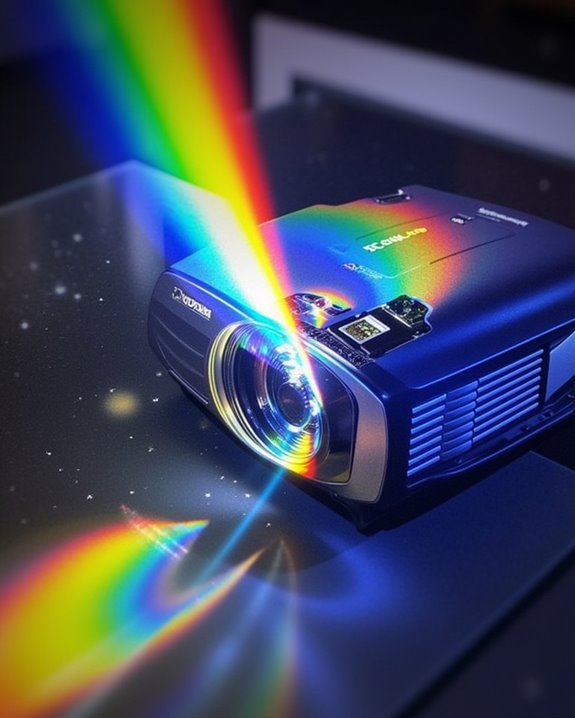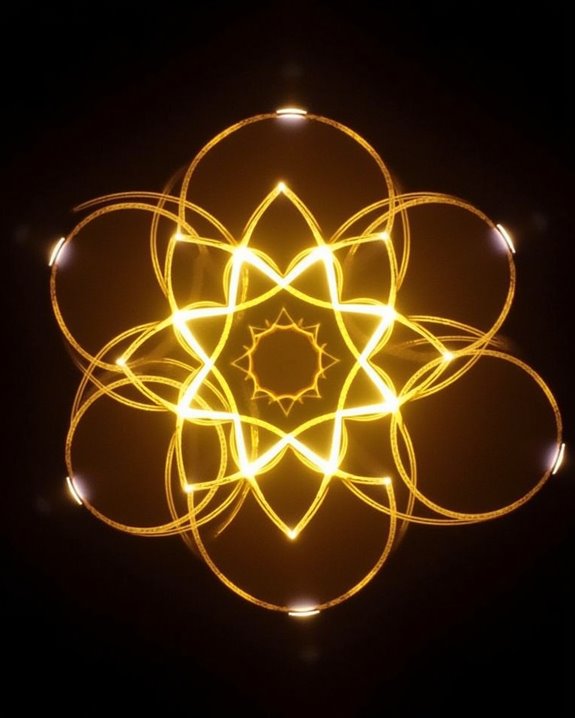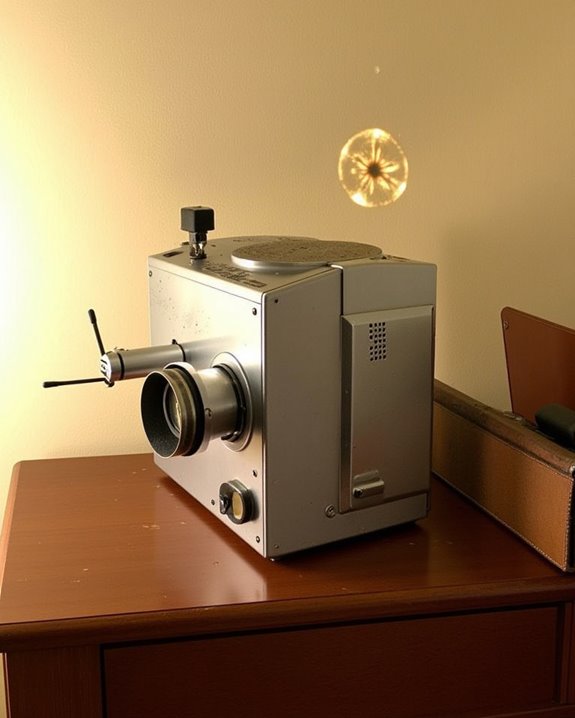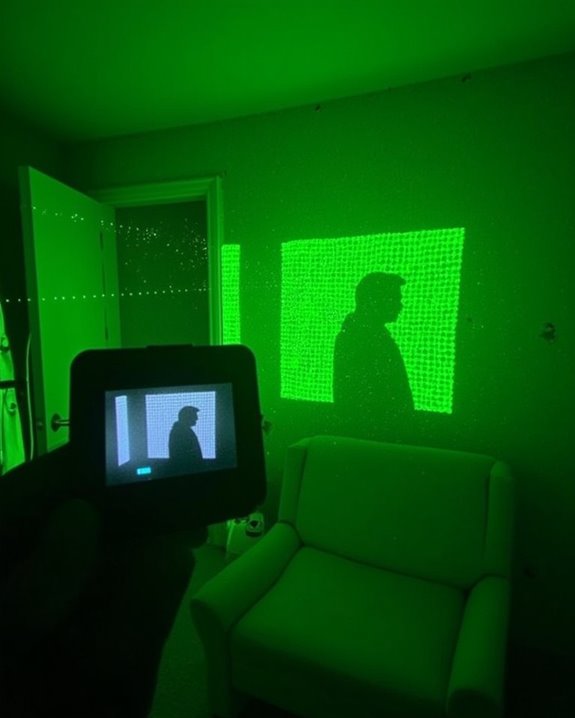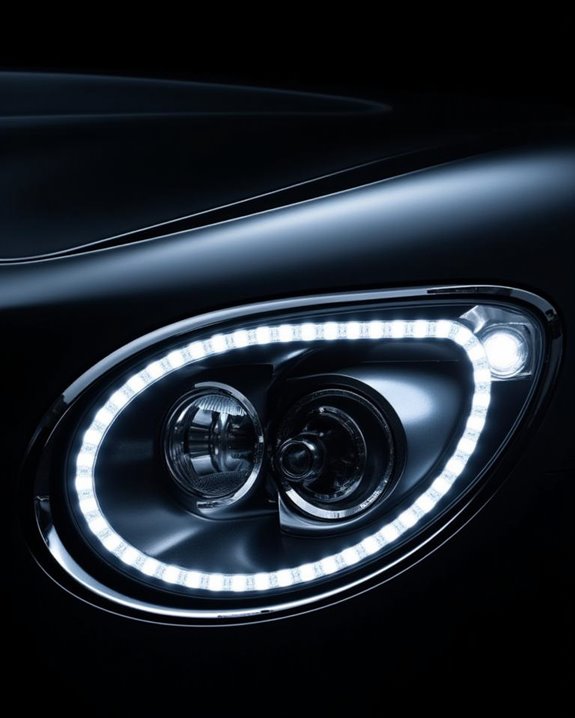You might be surprised to learn that DLP projectors power most modern movie theaters with just a single chip containing millions of microscopic mirrors. These tiny mirrors—each smaller than a human hair—tilt thousands of times per second to create the crisp, vibrant images you see on screen. When you understand how DLP technology works, you’ll gain insight into why these projectors deliver superior contrast and color accuracy compared to traditional projection methods. The science behind this remarkable technology reveals why professionals from cinema operators to business presenters consistently choose DLP systems.
Key Takeaways
- DLP projectors use Digital Micromirror Devices with tiny tiltable mirrors that reflect light to create images on a screen.
- Developed by Texas Instruments in 1987, DLP technology creates images by precisely controlling thousands of microscopic mirrors.
- Color is produced either through a spinning color wheel in single-chip designs or separate DMDs with dichroic prisms in three-chip systems.
- DLP projectors deliver superior contrast ratios, deeper blacks, and sharper resolution compared to LCD technology.
- Modern DLP projectors use LED or laser light sources for better energy efficiency, longer lifespan, and enhanced color reproduction.
The Evolution of DLP Projector Technology
Since its inception in the late 1980s, Digital Light Processing (DLP) technology has revolutionized the way we experience projected images in both commercial and home environments. Developed by Texas Instruments under Professor Larry Hornbeck in 1987, the Digital Micromirror Device (DMD) wasn’t officially announced until 1995, with the first commercial DLP projectors entering the market the following year. Digital Projection Ltd introduced the first dedicated DLP-based projector in 1997, marking a significant milestone in projection brightness and quality.
Market adoption expanded rapidly throughout the early 2000s as DLP technology offered distinct advantages over traditional methods, particularly in contrast ratios and image depth. The introduction of Texas Instruments’ Dark Chip 4 in 2007 enhanced native contrast by 30%, cementing DLP’s reputation as a reliable, high-performance technology for both consumer entertainment and professional applications. Today, DLP projectors are integrated into a variety of models supporting 4K resolution and high brightness levels, making them ideal for both indoor and outdoor use.
How DLP Technology Works: a Deep Dive Into Digital Micromirror Devices
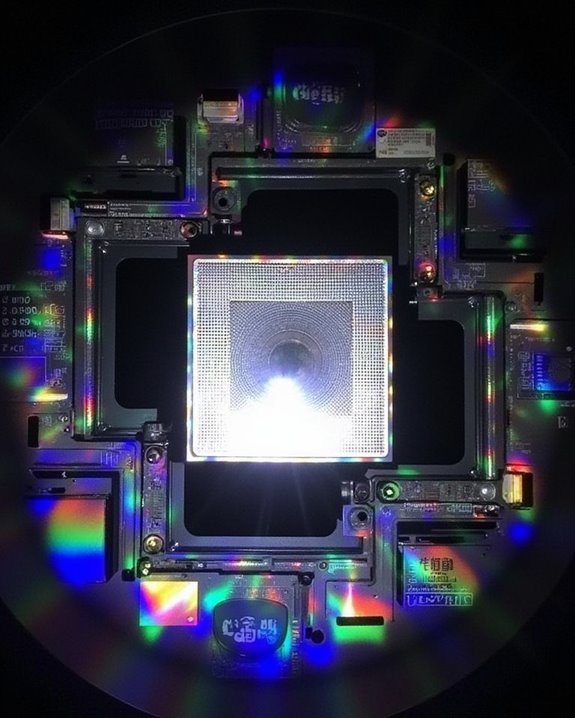
At the core of every DLP projector lies an engineering marvel known as the Digital Micromirror Device (DMD), which transforms digital signals into the vibrant images you’ll see on screen. This optical MEMS consists of hundreds of thousands of microscopic mirrors, each representing a single pixel, mounted on hinges that enable them to tilt between +12° and -12° positions.
The micromirror mechanics involve precision-engineered tilt actions controlled by memory cells beneath each mirror, determining whether light reflects toward the projection lens (“on”) or away from it (“off”). Sophisticated control circuitry, including a dedicated controller chip, manages the complex data flow and precise timing required for mirror movement. This circuitry synchronizes mirror positions with color wheel rotation or RGB light sources, creating color images through pulse-width modulation that controls how long each mirror stays “on” during a frame.
Many modern DLP projectors incorporate advanced features such as HDR support and 1000 ANSI lumens brightness, significantly enhancing contrast and image quality even in various lighting conditions.
The Optical System and Light Path in DLP Projectors
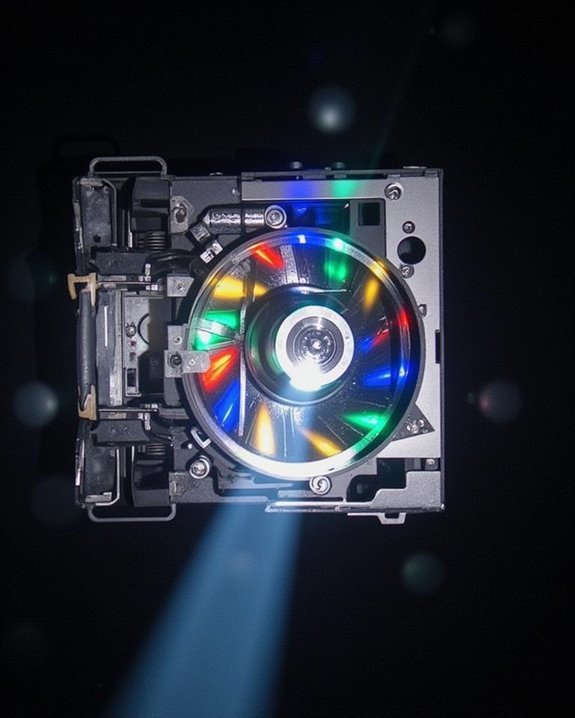
The intricate optical system within a DLP projector transforms raw illumination into the crisp, clear images you’ll see on your projection surface, functioning as a complex pathway that guides light from source to screen. Your projector’s light source—whether it’s a metal halide lamp, LED, or laser-phosphor—begins the optical path by emitting bright illumination that’s collected by the condenser lens and directed toward the DMD chip.
In single-chip designs, a color wheel filters the light sequentially into RGB components, while three-chip systems use dichroic prisms to split the light toward dedicated DMDs for each color. After the tiny mirrors reflect the light, a Total Internal Reflection prism recombines the color components before the projection lens focuses everything onto your screen with superior color uniformity. The quality of the projection is also influenced by the projection surface and room lighting, which can enhance or diminish the crispness and brightness of the final image.
Color Wheel Technology and Image Processing
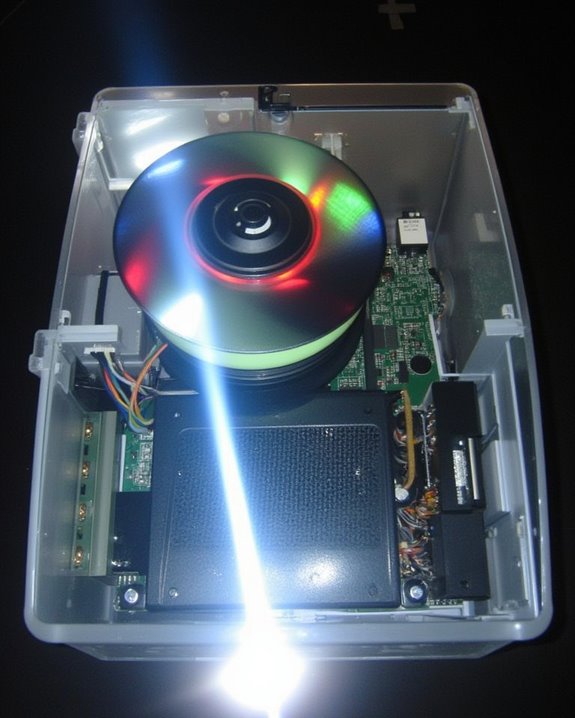
Understanding color wheel technology forms the foundation of how DLP projectors create the vibrant, color-rich images you’ll see on your screen. This rotating disc, spinning at several thousand RPM, contains segments of primary colors (red, green, and blue) that filter white light sequentially.
When the color wheel spins, it synchronizes with the DMD chip, which reflects light through millions of microscopic mirrors. These mirrors tilt to direct colored light toward or away from your screen, creating precise color blending for each pixel. Your projector processes each primary color in sequence, combining them at speeds your eye perceives as a single, complete image. Higher-quality DLP systems utilize faster color wheels with additional segments to improve color accuracy and reduce the “rainbow effect” some viewers experience. Modern alternatives include LED and laser technologies, which may eliminate traditional color wheels altogether.
LED and Laser DLP Projectors: Next-Generation Advancements
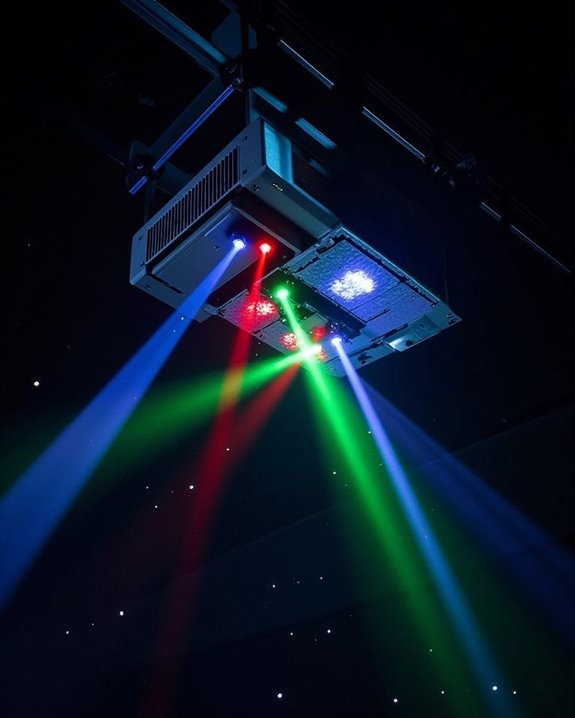
Modern DLP projection technology has evolved dramatically with the introduction of LED and laser light sources, revolutionizing what’s possible in both home theater and professional settings. These eco-friendly innovations deliver exceptional energy efficiency while reducing maintenance needs, with LED and laser light sources lasting up to 30,000 hours compared to traditional lamps’ 5,000-hour lifespan.
You’ll notice significant improvements in brightness and color reproduction, particularly with RGB laser systems that support wider color gamuts beyond standard specifications. The compact design of DLP chips, when paired with LED or laser illumination, enables sleeker, space-saving projectors with user interface enhancements like instant on/off functionality. Despite higher initial costs, the total ownership expense decreases substantially due to eliminated lamp replacements, reduced power consumption, and minimal maintenance requirements, making these next-generation projectors increasingly practical for everyday use.
Comparing DLP to LCD and Other Projection Technologies
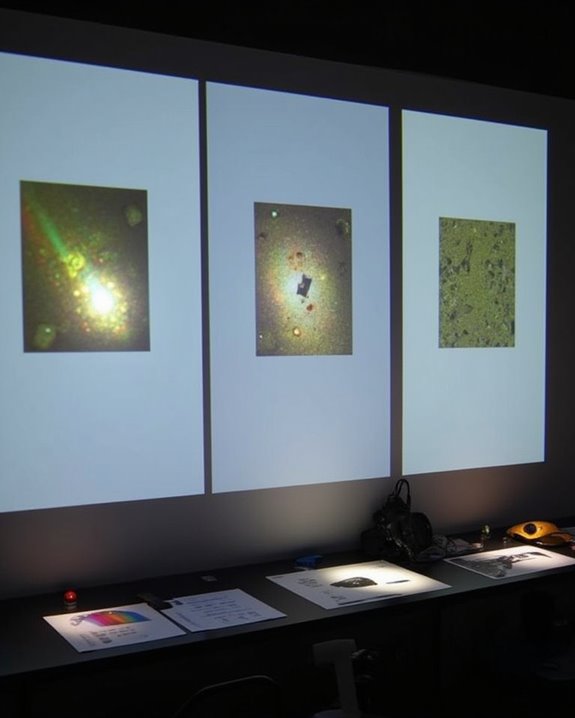
While LED and laser light sources advance DLP technology, it’s important to examine how DLP stacks up against competing projection systems like LCD.
DLP projectors excel with superior contrast ratios and resolution clarity, producing deeper blacks and more vibrant whites than their LCD counterparts. Their single-chip design, utilizing micromirrors for pixel control, enables more precise color manipulation across a wider dynamic range, though LCD projectors often provide better color accuracy for video applications. You’ll find DLP projectors are typically more portable and easier to maintain, with laser models offering up to 25,000 hours of lamp life compared to LCD’s shorter-lived metal halide lamps. For home theaters and gaming environments where contrast matters, DLP projectors deliver cinema-grade image quality, while 3LCD technology might be preferable for environments prioritizing pure color reproduction over contrast.
Popular Applications and Use Cases for DLP Projectors
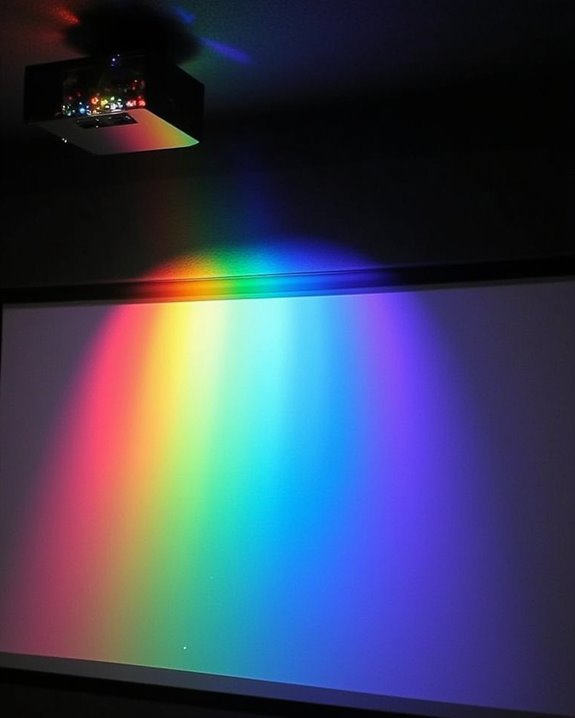
Where can you find DLP projectors making the most impact today? These versatile devices have become staples in multiple sectors due to their cost efficiency and user customization options. In commercial settings, you’ll find them illuminating conference rooms and retail displays with their sharp, reliable images. Educational institutions rely on DLP projectors for classrooms and training sessions, where their clarity enhances learning experiences.
Home entertainment represents another significant application, with DLP technology powering home theaters and gaming setups that benefit from quick response times and high resolution. Industrial applications include simulation training and product demonstrations at exhibitions, where their light efficiency and color control capabilities shine. From corporate events to worship centers, these projectors deliver consistent performance across diverse environments, making them the preferred choice for professionals seeking dependable visual solutions.
DLP Technology in 3D Printing and Beyond
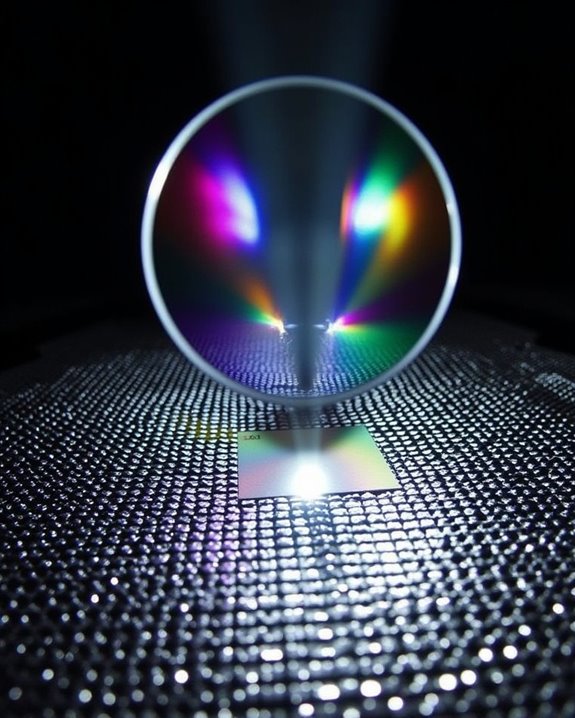
Beyond their traditional projection roles, DLP technology has revolutionized the world of 3D printing through its innovative application of digital micromirror devices (DMDs). This technology employs photopolymerization, where UV light precisely cures liquid resin layer by layer to create detailed objects. Historical trends show that DLP, a form of stereolithography, has overcome early limitations to offer exceptional precision and smooth surface finishes.
Market adoption has accelerated as costs decreased, making DLP technology accessible for various applications beyond 3D printing. You’ll find DLP implementations in medical imaging, industrial prototyping, and display technologies, where its high-resolution capabilities provide significant advantages. While challenges remain in scaling capabilities and managing resin safety, ongoing research continues to expand DLP’s potential through improved resolution and more efficient light sources.
Frequently Asked Questions
How Long Do DLP Projector Bulbs Typically Last?
90% of traditional DLP projector bulbs last 2,000-5,000 hours. You’ll need to contemplate lamp lifespan when purchasing. LED and laser models offer up to 30,000 hours before bulb replacement becomes necessary.
Can DLP Projectors Cause the “Rainbow Effect” and Who’s Affected?
Yes, DLP projectors can cause the rainbow effect due to sequential color separation from the rotating color wheel. You’ll only notice it if you’re sensitive to it, which affects about 30% of viewers.
Are DLP Projectors Suitable for Permanent Ceiling Installations?
Like John’s basement theater setup, you’ll find DLP projectors excellent for ceiling installations. They’re known for their long-term durability and versatile mounting options—perfect for permanent setups that need reliable, consistent performance over time.
How Does Ambient Light Affect DLP Projector Image Quality?
Ambient light interference washes out your projected image, reducing contrast and color vibrancy. You’ll notice diminished detail visibility and overall faded appearance. For ideal viewing conditions, use light-rejecting screens or control your room’s lighting.
What Maintenance Is Required for DLP Projectors Compared to Other Technologies?
You’ll need less filter replacement for DLP projectors than LCD ones. Keep your cooling system clean by vacuuming vents regularly. While maintenance is simpler than LCD, DLP requires more attention than laser projectors.

